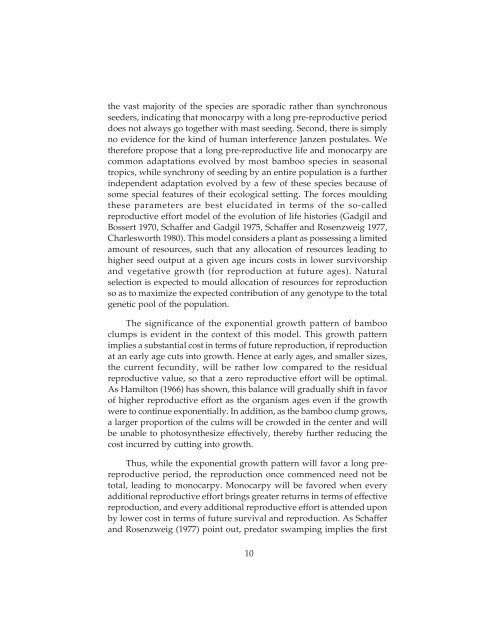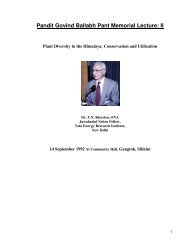Pt. Govind Ballabh Pant Memorial Lecture : XI
Pt. Govind Ballabh Pant Memorial Lecture : XI
Pt. Govind Ballabh Pant Memorial Lecture : XI
- No tags were found...
Create successful ePaper yourself
Turn your PDF publications into a flip-book with our unique Google optimized e-Paper software.
the vast majority of the species are sporadic rather than synchronousseeders, indicating that monocarpy with a long pre-reproductive perioddoes not always go together with mast seeding. Second, there is simplyno evidence for the kind of human interference Janzen postulates. Wetherefore propose that a long pre-reproductive life and monocarpy arecommon adaptations evolved by most bamboo species in seasonaltropics, while synchrony of seeding by an entire population is a furtherindependent adaptation evolved by a few of these species because ofsome special features of their ecological setting. The forces mouldingthese parameters are best elucidated in terms of the so-calledreproductive effort model of the evolution of life histories (Gadgil andBossert 1970, Schaffer and Gadgil 1975, Schaffer and Rosenzweig 1977,Charlesworth 1980). This model considers a plant as possessing a limitedamount of resources, such that any allocation of resources leading tohigher seed output at a given age incurs costs in lower survivorshipand vegetative growth (for reproduction at future ages). Naturalselection is expected to mould allocation of resources for reproductionso as to maximize the expected contribution of any genotype to the totalgenetic pool of the population.The significance of the exponential growth pattern of bambooclumps is evident in the context of this model. This growth patternimplies a substantial cost in terms of future reproduction, if reproductionat an early age cuts into growth. Hence at early ages, and smaller sizes,the current fecundity, will be rather low compared to the residualreproductive value, so that a zero reproductive effort will be optimal.As Hamilton (1966) has shown, this balance will gradually shift in favorof higher reproductive effort as the organism ages even if the growthwere to continue exponentially. In addition, as the bamboo clump grows,a larger proportion of the culms will be crowded in the center and willbe unable to photosynthesize effectively, thereby further reducing thecost incurred by cutting into growth.Thus, while the exponential growth pattern will favor a long prereproductiveperiod, the reproduction once commenced need not betotal, leading to monocarpy. Monocarpy will be favored when everyadditional reproductive effort brings greater returns in terms of effectivereproduction, and every additional reproductive effort is attended uponby lower cost in terms of future survival and reproduction. As Schafferand Rosenzweig (1977) point out, predator swamping implies the first10











